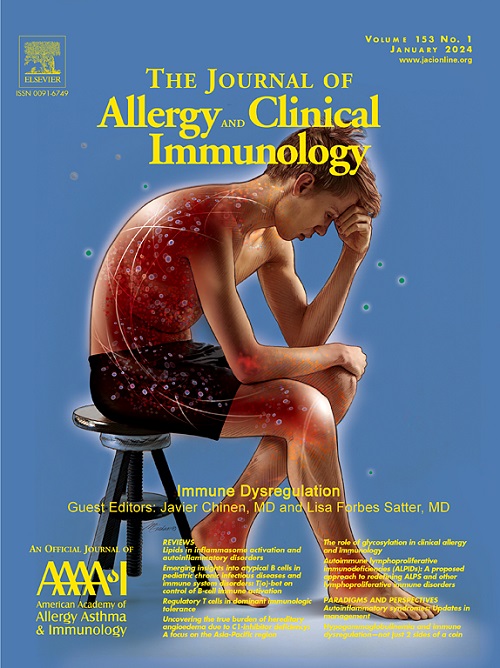Antigenic determinants underlying IgE-mediated anaphylaxis to peanut
IF 11.4
1区 医学
Q1 ALLERGY
引用次数: 0
Abstract
Background
Studies of human IgE and its targeted epitopes on allergens have been very limited. We established a method to immortalize IgE-encoding B cells from patients with allergy.
Objective
We sought to develop an unbiased and comprehensive panel of peanut-specific human IgE mAbs to characterize key immunodominant antigenic regions and epitopes on peanut allergens to map molecular interactions responsible for inducing anaphylaxis.
Methods
Using human hybridoma technology to immortalize IgE-encoding B cells from peripheral blood of subjects with severe peanut allergy, we generated a panel of naturally occurring human IgE mAbs in an unbiased manner. Isolated IgE mAbs were characterized extensively in allergen binding assays, peptide array analysis, antigenic mapping, binding kinetic analysis, serum blocking, skin testing inhibition, and functional assessment using human FCεRI transgenic mice.
Results
We created a large panel of 54 peanut-specific IgE mAbs, of which 63% were specific for Ara h 2 and/or Ara h 6. Pairs of IgE mAbs with the same antigen specificity but different binding sites were able to mediate passive systemic anaphylaxis in FCεRI transgenic mice. A single mAb targeting the repetitive motif on Ara h 2 was able to induce degranulation and anaphylaxis on its own. IgG1 switch variant immunoglobulins of the IgE mAb inhibited binding of 30% to 60% of patients’ IgE to peanut extract (ImmunoCAP) and reduced peanut extract–induced skin wheal sizes by 1.6 to 7.4 mm in patients with peanut allergy.
Conclusion
We created a molecular map of the IgE antibody response to the most important peanut allergen proteins to enable the design of new allergy immunotherapies and vaccines.
ige介导的花生过敏反应的抗原决定因素。
人类IgE及其对过敏原的靶向表位的研究非常有限。我们已经建立了一种从过敏个体中永生IgE编码B细胞的方法。目的:建立一个公正和全面的花生特异性人IgE单抗,以表征花生过敏原的关键免疫优势抗原区和表位,以绘制诱导过敏反应的分子相互作用。方法采用人杂杂瘤技术,从严重花生过敏受试者的外周血中永生化编码IgE的B细胞,以无偏倚的方式产生一组天然存在的人IgE单克隆抗体。分离的IgE单抗在过敏原结合、肽阵列分析、抗原定位、结合动力学分析、血清阻断、皮肤试验抑制和人类FcεRI转基因小鼠的功能评估中得到了广泛的鉴定。我们创建了54个花生特异性IgE单克隆抗体,其中63%特异于Ara h2和/或6。对具有相同抗原特异性但结合位点不同的IgE单抗能够介导FcεRI转基因小鼠的被动全身性过敏反应。单个mAb靶向Ara h2上的重复基序,能够自行诱导脱粒和过敏反应。IgE单抗的IgG1切换变体免疫球蛋白抑制患者对花生提取物的IgE结合在30-60% (ImmunoCAP)之间,并使花生过敏患者的花生提取物诱导的皮肤轮大小减少1.6-7.4毫米。结论建立了花生最重要过敏原蛋白的IgE抗体反应分子图谱,为设计新的过敏免疫疗法和疫苗提供了基础。
本文章由计算机程序翻译,如有差异,请以英文原文为准。
求助全文
约1分钟内获得全文
求助全文
来源期刊
CiteScore
25.90
自引率
7.70%
发文量
1302
审稿时长
38 days
期刊介绍:
The Journal of Allergy and Clinical Immunology is a prestigious publication that features groundbreaking research in the fields of Allergy, Asthma, and Immunology. This influential journal publishes high-impact research papers that explore various topics, including asthma, food allergy, allergic rhinitis, atopic dermatitis, primary immune deficiencies, occupational and environmental allergy, and other allergic and immunologic diseases. The articles not only report on clinical trials and mechanistic studies but also provide insights into novel therapies, underlying mechanisms, and important discoveries that contribute to our understanding of these diseases. By sharing this valuable information, the journal aims to enhance the diagnosis and management of patients in the future.

 求助内容:
求助内容: 应助结果提醒方式:
应助结果提醒方式:


